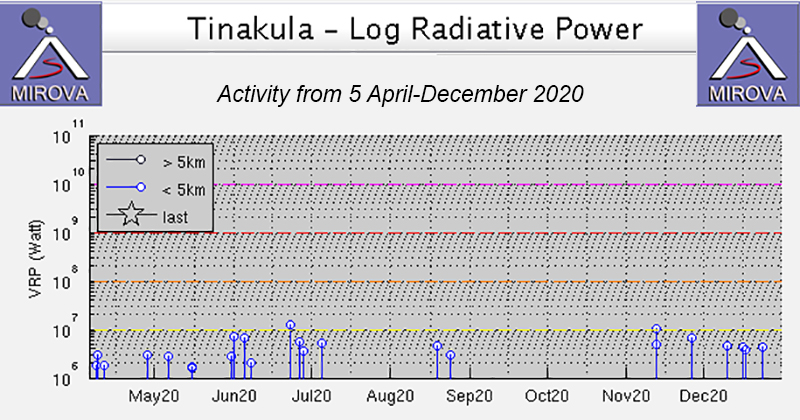Report on Tinakula (Solomon Islands) — January 2021
Bulletin of the Global Volcanism Network, vol. 46, no. 1 (January 2021)
Managing Editor: Edward Venzke.
Edited by Kadie L. Bennis.
Tinakula (Solomon Islands) Intermittent gas-and-steam plumes and weak thermal anomalies during July-December 2020
Please cite this report as:
Global Volcanism Program, 2021. Report on Tinakula (Solomon Islands) (Bennis, K.L., and Venzke, E., eds.). Bulletin of the Global Volcanism Network, 46:1. Smithsonian Institution. https://doi.org/10.5479/si.GVP.BGVN202101-256010
Tinakula
Solomon Islands
10.386°S, 165.804°E; summit elev. 796 m
All times are local (unless otherwise noted)
Tinakula is located 100 km NE of the Solomon Trench at the N end of the Santa Cruz. The current eruption began in December 2018 and has recently been characterized by intermittent small thermal anomalies and gas-and-steam plumes (BGVN 45:07), which continued into the current reporting period of July-December 2020. Information primarily comes from various satellite data, as ground observations are rarely available.
Infrared MODIS satellite data processed by MIROVA (Middle InfraRed Observation of Volcanic Activity) showed a total of ten low-power thermal anomalies during July through December; one anomaly was detected in early July, two in late August, three in November, and four in December (figure 44). A single MODVOLC alert was issued on 16 December, which was visible in Sentinel-2 thermal satellite imagery on 17 December (figure 45). Though clouds often obscured the view of the summit crater, Sentinel-2 satellite imagery showed intermittent dense gas-and-steam plumes rising from the summit that drifted in different directions (figure 45).
 |
Figure 44. Low-power thermal anomalies at Tinakula were detected intermittently during April-December 2020 by the MIROVA system (Log Radiative Power). Courtesy of MIROVA. |
Geological Summary. The small 3.5-km-wide island of Tinakula is the exposed summit of a massive stratovolcano at the NW end of the Santa Cruz islands. It has a breached summit crater that extends from the summit to below sea level. Landslides enlarged this scarp in 1965, creating an embayment on the NW coast. The Mendana cone is located on the SE side. The dominantly andesitic volcano has frequently been observed in eruption since the era of Spanish exploration began in 1595. In about 1840, an explosive eruption apparently produced pyroclastic flows that swept all sides of the island, killing its inhabitants. Recorded eruptions have frequently originated from a cone constructed within the large breached crater. These have left the upper flanks and the steep apron of lava flows and volcaniclastic debris within the breach unvegetated.
Information Contacts: MIROVA (Middle InfraRed Observation of Volcanic Activity), a collaborative project between the Universities of Turin and Florence (Italy) supported by the Centre for Volcanic Risk of the Italian Civil Protection Department (URL: http://www.mirovaweb.it/); Hawai'i Institute of Geophysics and Planetology (HIGP) - MODVOLC Thermal Alerts System, School of Ocean and Earth Science and Technology (SOEST), Univ. of Hawai'i, 2525 Correa Road, Honolulu, HI 96822, USA (URL: http://modis.higp.hawaii.edu/); Sentinel Hub Playground (URL: https://www.sentinel-hub.com/explore/sentinel-playground).


